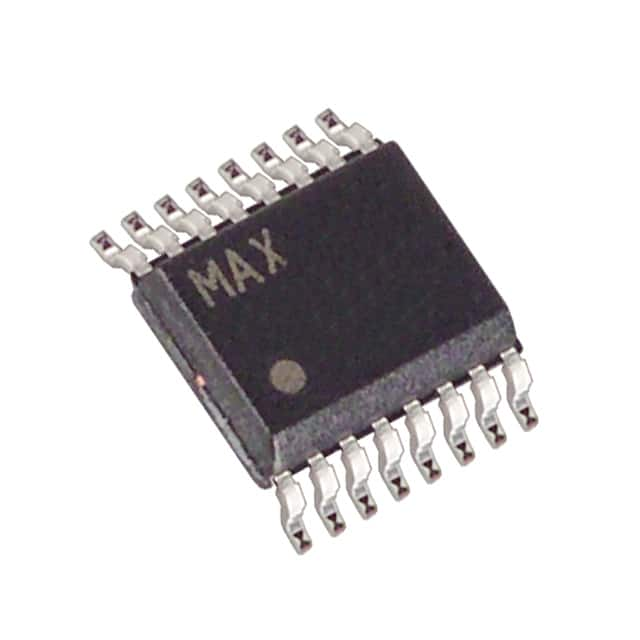MAX6950CEE+T
Product Overview
Category
The MAX6950CEE+T belongs to the category of integrated circuits (ICs) and specifically falls under the family of LED display drivers.
Use
This product is primarily used for driving LED displays, making it suitable for a wide range of applications including consumer electronics, industrial equipment, and automotive displays.
Characteristics
- High integration and compact design
- Low power consumption
- Wide operating voltage range
- Serial interface for easy control
- Capable of driving multiple LED segments
Package
The MAX6950CEE+T is available in a compact 16-pin QSOP package, which offers space-saving benefits and ease of integration into various electronic designs.
Essence
The essence of MAX6950CEE+T lies in its ability to efficiently drive LED displays with minimal power consumption and a high level of integration.
Packaging/Quantity
The MAX6950CEE+T is typically supplied in tape and reel packaging, with quantities varying based on the specific order requirements.
Specifications
- Supply Voltage: 2.7V to 5.5V
- Operating Temperature Range: -40°C to +85°C
- Maximum LED Current: 20mA
- Number of Drivers: 16
- Communication Interface: Serial I/O
Detailed Pin Configuration
The MAX6950CEE+T features a 16-pin QSOP package with the following pin configuration: 1. GND 2. DIN 3. DOUT 4. CS 5. CLK 6. BLANK 7. ISET 8. V+ 9. SEG0 10. SEG1 11. SEG2 12. SEG3 13. SEG4 14. SEG5 15. SEG6 16. SEG7
Functional Features
- Serial interface for easy control and communication with microcontrollers or other devices
- Individual segment control for precise LED display manipulation
- Built-in current limiting for efficient power management
- Blank input for display blanking control
- Integrated oscillator for internal timing
Advantages and Disadvantages
Advantages
- High level of integration reduces external component count
- Low power consumption enhances energy efficiency
- Versatile serial interface simplifies system integration
- Precise LED control for customized display designs
Disadvantages
- Limited to driving LED displays and may not be suitable for other applications
- Requires understanding of serial communication protocols for effective utilization
Working Principles
The MAX6950CEE+T operates by receiving data through its serial interface and using this information to control the individual segments of connected LED displays. It incorporates an internal oscillator for timing and current limiting to ensure efficient power management.
Detailed Application Field Plans
The MAX6950CEE+T finds application in various fields including: - Consumer Electronics: LED indicators, display panels - Industrial Equipment: Control panels, status indicators - Automotive Displays: Dashboard indicators, infotainment systems
Detailed and Complete Alternative Models
Some alternative models to MAX6950CEE+T include: - MAX7219CNG+: Another LED display driver with similar functionality - TLC5940PWPR: Offers extended grayscale control for LED displays - HT16K33: Integrated matrix LED controller with versatile features
In conclusion, the MAX6950CEE+T serves as a versatile and efficient solution for driving LED displays across a wide range of applications, offering high integration, low power consumption, and precise control capabilities.
Word Count: 554
तकनीकी समाधानों में MAX6950CEE+T के अनुप्रयोग से संबंधित 10 सामान्य प्रश्नों और उत्तरों की सूची बनाएं
What is the MAX6950CEE+T?
- The MAX6950CEE+T is a compact, serial-interfaced LED display driver that can be used to control up to 16 seven-segment displays or 128 individual LEDs.
What is the maximum supply voltage for the MAX6950CEE+T?
- The maximum supply voltage for the MAX6950CEE+T is 5.5V.
How many digits can the MAX6950CEE+T control?
- The MAX6950CEE+T can control up to 16 seven-segment digits.
What communication interface does the MAX6950CEE+T support?
- The MAX6950CEE+T supports a simple, 2-wire serial interface, making it easy to integrate into various systems.
Can the MAX6950CEE+T dim the LED displays?
- Yes, the MAX6950CEE+T supports adjustable brightness control for the LED displays.
What is the typical operating frequency for the MAX6950CEE+T?
- The typical operating frequency for the MAX6950CEE+T is 400kHz.
Does the MAX6950CEE+T have built-in debounce circuitry for switches?
- Yes, the MAX6950CEE+T includes built-in debounce circuitry for interfacing with switches.
Is the MAX6950CEE+T suitable for battery-powered applications?
- Yes, the low power consumption and wide supply voltage range make the MAX6950CEE+T suitable for battery-powered applications.
Can the MAX6950CEE+T be cascaded to control more than 16 digits?
- Yes, multiple MAX6950CEE+T devices can be cascaded to control larger displays or arrays of LEDs.
What are some common applications for the MAX6950CEE+T?
- Common applications include industrial control panels, digital clocks, panel meters, and other instrumentation displays.


